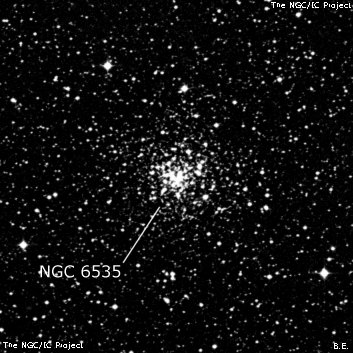
William Herschel discovered NGC 6535 = Au 38 on 24 Aug 1780 with his 6.2-inch reflector (used to discover Uranus) during his initial inspection of Flamsteed stars. According to Wolfgang Steinicke, who uncovered this observation ("a nebula with stars") in his Herschel research, this was the first nebula he discovered! As a result NGC 7009 = Saturn Nebula, found on 7 Sep 1782 with the same reflector, was his second discovery. The same night he also observed M8 ("a Nebula not marked in the map full of stars in via Lactea"), before being aware of Messier's catalogue.
John Russell Hind independently discovered NGC 6535 on 26 Apr 1852 (MN, 12, 208) with a 7-inch Dolland refractor at George Bishop's private observatory in London and recorded "a nebulous object which does not occur in any of the Catalogues of Nebulae hitherto consulted. It is very small and rather faint, perhaps 1' in diameter and is preceded a few seconds by a very minute hazy-looking star." Hind is credited with the discovery in the NGC. Auwers observed it with the 6-inch Heliometer at Königsberg Observatory and reported "pF, round, 2' diameter, gradually very slightly bM."
Based on photographs with the 30" reflector in 1914-16 at the Helwan Observatory, NGC 6535 was reported as a "small loose cluster of a few bright stars. No nebulosity."
400/500mm - 17.5" (8/10/91): moderately bright, roughly circular, 3' diameter. Three mag 13 stars and a mag 14 star are almost on a line oriented N-S on the west edge. Very mottled and granular appearance with an irregular outline. Can just steadily resolve a few very faint stars and another half a dozen extremely faint stars pop in and out of view over the core. Located within a rich star field.
600/800mm - 24" (7/30/16): at 500x; moderately bright and large, roundish, ~3' diameter, fairly weak concentration with a slightly brighter core. A mag 13 star is on the southwest side of the halo, two mag 13.5 stars on the west side and another near the northwest edge. A half-dozen stars additional stars are resolved in the halo with a few additional around the edges of the halo. A number more scintillate in and out of view, emerging for brief moments in better seeing, ~20-25 total seen in the halo. The core region includes another half-dozen stars with one standing out more prominently.
Notes by Steve Gottlieb